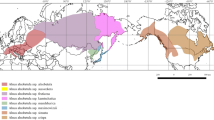Abstract
The distribution of nine chloroplast DNA haplotypes in four insular North-Atlantic and four European coastal Atlantic populations of Calluna vulgaris in the glacial zone of the range has been analyzed in comparison with that in six marginal southern populations in the nonglacial zone of the Atlantic and Mediterranean regions. As a result, two hypothetical Pleistocene refugia (HPRs) for this C. vulgaris population group have been revealed, one in the Cévennes mountain range and the other in the Southern Alps (Trento). Judging from the 1–FST value, it has been found that the group of populations in the glacial Atlantic zone and adjacent European coastal Atlantic region is genetically similar to the HPR in the Cévennes at a highly significant level (p ≥ 0.999) and less similar to the HPR in Trento; however, it differs significantly from other Mediterranean and Atlantic populations. It has been concluded that the most probable hypothetical Pleistocene refugium for the recent C. vulgaris populations of the northeastern Atlantic and European coastal Atlantic regions was in the west of the Mediterranean, in the Cévennes, while the additional refugium was in the Southern Alps. Possible directions of the postglacial dispersal and recolonization of habitats by C. vulgaris populations from the western Mediterranean to the northeast of the Atlantic and to Scandinavia have been revealed.
Similar content being viewed by others
References
Gorchakovskii, P.L., Heather: Geography, ecology, and history of range formation, Bot. Zh., 1962, vol. 47, no. 9, pp. 1244–1257.
Gimingham, C.H., Ecology of Heathland, New York: Halsted Press, 1975.
Lang, G., Quartäre Vegetationsgeschichte Europas: Methoden und Ergebnisse, Jena: Gustav Fisher, 1994.
Sannikov, S.N., Petrova, I.V., and Cherepanova, O.E., Alternative hypotheses for the origin of heather, Calluna vulgaris (L.) Hull, Eko-Potentsial, 2016, no. 2 (14), pp. 28–40.
Grant, S.A. and Hunter, R.F., Ecotypic differentiation of Calluna vulgaris (L.) in relation to altitude, New Phytol., 1962, vol. 61, pp. 44–55.
Dommée, B., Expériences sur le régime de la reproduction et sur la structure génetique des populations de Calluna vulgaris, Comptes Rendus Acad. Sci. Paris, Ser. D, 1969, vol. 268, pp. 2582–2584.
Sannikov, S.N., Petrova, I.V., Polezhaeva, M.A., Mishchikhina, Yu.D., Cherepanova, O.E., and Dymshakova, O.S., Genetic divergence of Eastern European and Tobol populations of Calluna vulgaris (L.) Hull, Russ. J. Ecol., 2013, vol. 44, no. 2, pp. 118–122.
Sannikov, S.N., Petrova, I.V., Dymshakova, O.S., and Cherepanova, O.E., Genetic and phenotypic differentiation of Calluna vulgaris (L.) Hull. in Pritobolie and Europe, Russ. J. Genet., 2014, vol. 50, no. 9, pp. 925–933.
Cherepanova, O.E., Petrova, I.V., and Mishchikhina, Y.D., Leaf morphology and anatomy in marginal populations of common heather, Calluna vulgaris (L.) Hull from West Siberia and Atlantic Europe, Skvortsovia: Int. J. Salicol. Plant Biol., 2015, vol. 2, no. 1, pp. 35–44.
Rendell, S. and Ennos, R.A., Chloroplast DNA diversity in Calluna vulgaris (heather) populations in Europe, Mol. Ecol., 2002, vol. 11, no. 1, pp. 69–78.
Sannikov, S.N., Paule, L., and Egorov, E.V., Identification of probable Pleistocene refugia of Pinus sylvestris L. in Europe, For. Genet., 2013, vol. 13, no. 4, pp. 201–206.
Sannikov, S.N., Petrova, I.V., Egorov, E.V., and Sannikova, N.S., A system of Pleistocene refugia for Pinus sylvestris L. in the southern marginal part of the species range, Russ. J. Ecol., 2014, vol. 45, no. 3, pp. 167–173.
Egorov, E.V., Allozyme polymorphism and differentiation of Pinus sylvestris L. populations in Central Siberia and Transbaikalia, Sib. Lesn. Zh., 2016, no. 5, pp. 12–20.
Slatkin, M., Gene flow in natural populations, Ann. Rev. Ecol. Syst., 1985, vol. 16, pp. 393–430.
Nei, M., Molecular Evolutionary Genetics, New York: Columbia Univ. Press, 1987.
Devey, M.E., Bell, J.C., and Smith, D.N., A genetic linkage map for Pinus radiata based on RFLP, RAPD and microsatellite markers, Theor. Appl. Genet., 1996, vol. 92, pp. 673–679.
Dowling, T.E., Moritz, C., and Palmer, J.D., Nucleic acids II: Restriction site analysis, in Molecular Systematics, Hills, D.M. and Moritz, C., Eds., Sunderland, MA: Sinauer Assoc., 1990, pp. 250–317.
Hall, T.A., BIOEDIT: A user-friendly biological sequence alignment editor and analysis program for Windows 95/98/NT, Nucleic Acids Symp. Ser., 1999, vol. 41, pp. 95–98.
Excoffier, L., Laval, G., and Schneider, S., ARLEQUIN ver. 3.1: An Integrated Software Package for Population Genetics Data Analysis, Bern, Switzerland: Computational and Molecular Population Genetics Lab, Institute of Zoology, 2006. https://doi.org/cmpg.unibe.ch/software/arlequin3/arlequin3.1
Brewer, S., Recolonisation postglaciaire de quelques taxsons tempérés en Europe: Une approche spatiale et temporelle, Ph.D. Thesis, Université d’Aix-Marseille III, 2001.
Huntley, B. and Birks, H.J., An Atlas of Past and Pollen Maps for Europe: 0–13000 Years Ago, Cambridge: Cambridge Univ. Press, 1983.
Mahy, G., Ennos, R.A., and Jacquemart, Al., Allozyme variation and genetic structure of Calluna vulgaris (heather) populations in Scotland: The effect of postglacial recolonization, Heredity, 1999, vol. 82, pp. 654–660.
Mahy, G., Vekemans, X., Jacquemart, Al., and De Sloover, Jr., Allozyme diversity and genetic structure in south-western populations of heather, Calluna vulgaris, New Phytol., 1997, vol. 137, pp. 325–334.
Baker, R.R., The Evolutionary Ecology of Animal Migration, London: Hodder and Soughton, 1978.
Welch, D., Studies in the grazing of heather moorland in north-east Scotland: 4. Seed dispersal and plant establishment in dung, J. Appl. Ecol., 1985, vol. 22, pp. 461–472.
Gimingham, C.H., Biological flora of the British Isles: Calluna Salisb.: A monotypic genus, J. Ecol., 1960, vol. 48, no. 2, pp. 455–483.
Sannikov, S.N., Sannikova, N.S., and Petrova, I.V., Ocherki po teorii lesnoi populyatsionnoi biologii (Essays on the Theory of Forest Population Biology), Yekaterinburg: Ural. Otd. Ross. Akad. Nauk, 2012.
Author information
Authors and Affiliations
Corresponding author
Additional information
Original Russian Text © S.N. Sannikov, I.V. Petrova, L. Paule, E.V. Egorov, O.E. Cherepanova, O.S. Dymshakova, 2018, published in Ekologiya, 2018, No. 4, pp. 254–263.
Rights and permissions
About this article
Cite this article
Sannikov, S.N., Petrova, I.V., Paule, L. et al. Pleistocene Refugia for Calluna vulgaris (L.) Hull Populations in the European Atlantic Region. Russ J Ecol 49, 286–295 (2018). https://doi.org/10.1134/S1067413618030086
Received:
Published:
Issue Date:
DOI: https://doi.org/10.1134/S1067413618030086




